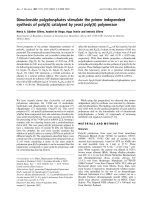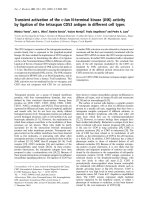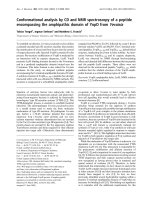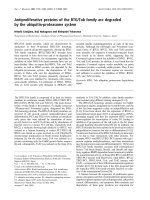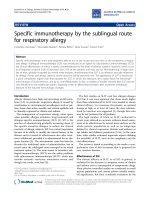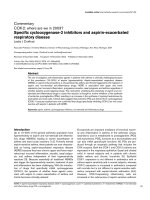Báo cáo y học: "Specific immunotherapy by the sublingual route for respiratory allergy" pot
Bạn đang xem bản rút gọn của tài liệu. Xem và tải ngay bản đầy đủ của tài liệu tại đây (230.52 KB, 6 trang )
REVIE W Open Access
Specific immunotherapy by the sublingual route
for respiratory allergy
Cristoforo Incorvaia
1*
, Simonetta Masieri
2
, Patrizia Berto
3
, Silvia Scurati
4
, Franco Frati
4
Abstract
Specific immunotherapy is the only treatment able to act on the causes and not only on the symptoms of respira-
tory allergy. Sublingual immunotherapy (SLIT) was introduced as an option to subcutaneous immunotherapy (SCIT),
the clinic al effectiveness of which is partly counter balanced by the issue of adverse systemic reactions, which occur
at a frequency of about 0.2% of injections and 2-5% of the patients and may also be life-threatening. A large num-
ber of trials, globally evaluated by several meta-analyses, demonstrated that SLIT is an effective and safe treatment
for allergic rhinitis and allergic asthma, severe reactions being extremely rare. The application of SLIT is favored by
a good compliance, higher than that reported for SCIT, in which the injections are a major factor for noncompli-
ance because of inconvenience, and by its cost-effectiveness. In fact, a number of studies showed that SLIT may be
very beneficial to the healthcare system, especially when its effectiveness persists after treatment withdrawal
because of the induced immunologic changes.
Introduction
Allergic diseases have high and increasing world preva-
lence [1,2]. In particular, respiratory allergy is caused by
sensitization to environmental aeroallergens such as pol-
lens, house dust mites, moulds, and animal epithelia and
is clinically expressed as rhinitis and asthma.
The management of respiratory allergy relies upon,
when possible, allergen avoidance, drug treatment, and
allergen-specific immunotherapy (SIT) [3]. SIT is the
practice of administering gradually increasing doses of
the specific causative allergen to reduce the clinical
reactivity of allergic subjects. SIT has central importance
because of its ability to modify the natural history of the
disease and to extend its effectiveness also after treat-
ment withdrawal, provided it is administered for an ade-
quate duration [4]. The subcutaneous route has been for
decades the traditional route of administration, but in
recent years the sublingual route emerged as an actual
treatment option [5]. The main reason to introduce sub-
lingual immunotherapy (SLIT) was the safety problems
with subcutaneous immunotherapy (SCIT), which may
include systemic reactions, sometimes severe and,
though very rarely, even fatal [6].
The first studies on SLIT used low allergen dosages
[7,8] but it was soon apparent that doses much higher
than those administered by SCIT were needed to ensure
clinical efficacy. In consensus documents, an optimal
dosage as high as at least 50 times the dose adminis-
tered by injection was suggested [3], though this ratio
may be not pertinent for all products.
The high number of trials on SLIT c onducted in
recent years allowed an accurate evidence-based assess-
ment of its effectiveness by several meta-analyses on the
whole patient population as well as on subgroups
defined by clinical expression (rhinitis and asthma) or
age (adults and children) parameters [9-16]. At the same
time, other studies evaluated important aspects defining
the suitability of SLIT, such a s the compliance and the
cost-effectiveness.
This review is aimed at providing to the reader a com-
prehensive view of this treatment that is proposed for
very common diseases.
Effectiveness of Slit
The clinical efficacy of SLIT, as of SIT in general, is
evaluated by the decrease in symptom scores of rhinitis
and asthma and in consumption of symptomatic drugs.
Many placebo-controlled studies are conducted on small
patient populations and cannot achieve reliable statisti-
cal significance, but their c ombined evaluation by the
* Correspondence:
1
Allergy/Pulmonary rehabilitation, Istituti Clinici di Perfezionamento,
Milan, Italy
Full list of author information is available at the end of the article
Incorvaia et al. Allergy, Asthma & Clinical Immunology 2010, 6:29
/>ALLERGY, ASTHMA & CLINICAL
IMMUNOLOGY
© 2010 Incorvaia et al; licensee BioMed Cent ral Ltd. This is an Open Access article distributed under the t erms of the Cre ative
Commons Attribution License (http://creativecommon s.org/licenses/by/2.0), whic h permits unrestricted use, distribution, and
reproduction in any medium, provided the original work is properly cited.
tool of meta-analysis is considered an adequate method
to obtain more solid data. The results are expressed as
standardized mean difference (SMD) and allow to com-
pare the effect of SLIT on actively and placebo-treated
patients.
The first meta-analysis on SLIT was published in
2005, including 22 randomized controlled studies [9].
Such analysis demonstrated a s ignificantly higher effi-
cacy of SLIT versus placebo, with SMD corresponding
to -0.42 for symptom scores (p = 0.002) and to -0.43 for
medication scores (p = 0.00003). The authors did not
succeed in detecting differences concerning subgroups,
such as the ki nd of allergen and patients age, because of
the relatively low numbers.
The meta-analysis by Olaguibel et al dealt with 7 ran-
domized controlled stud ies conducted on children aged
up to 14 years [10] and found that SLIT was signifi-
cantly effective on asthma symptoms (SMD - 1.42; p =
0.01) and on drug consumption (SMD -1.01; p = 0.06),
whiletheimprovementdidnotreachthesignificance
for nasal and conjunctival symptoms.
A further meta-analysis on SLIT in children was pub-
lished in 2006 [11]. In this case the evalua tion con-
cerned the efficacy on allergic rhinitis, in cluding 10
randomized controlled studies with an overall number
of 484 patients (245 actively and 239 placebo-treated).
A significant r eduction of both symptoms (SMD -0.56,
p = 0.02) and medication (SMD -0.76, p = 0.03) was
observed. A remarka ble aspect was provided from the
sub-analysis addressing the length of treatment and the
kind of allergen administered, which demonstrated a
higher efficacy for durations longer than 18 months and
for pollen allergens compared to house dust mites. In
the same year appeared a meta-analysis on the efficacy
of SLIT in asthma, which included 25 studies with an
overall number of 1706 patients [12]. Calculating the
SMD, the reduction of asthmatic symptoms did not
reach the statistical significance but usi ng the intenti on-
to-treat method for outcome measures, significant
decreases of asthma symptoms and drug consumption
and significant improvement of lung function and bron-
chial hyperreactivity were detected. The number needed
to treat (NNT) to avoid leaving 1 patie nt with the same
symptoms or worse was 3.7, that is, in the range of
those reported for injective SIT in asthmatic and rhinitic
patients. Better results were obtained by analyzing 9 stu-
dies on pediatric patients: the t otal number of patients
was 441, 232 actively treated and 209 placebo-treated
patients [13]. A significant reduction was found in both
symptoms scores (SMD -1.14; p = 0.02) and drug use
(SMD -1.63, p = 0.007).
The limit of meta-analysis is the relevant heterogeneit y
of the included studies, mainly because of different scor-
ing systems. Recent evaluations considered altogether the
meta-analyses but reached contrasting conclusions.
According to Nieto et al, who checked the data reported
in the original studies, the meta-analyses show “discre-
pancie s, inconsistencies, and lack of robustness” and “do
not provide enough evidence” for the current routine use
of SLIT in patients with allergic asthma or rhinoconjunc-
tivitis [14]. By contrast, the overall evaluation of all meta-
analyses (5 on SLIT and 2 on SCIT) by Compalati et a l,
despite a significant heterogeneity of studies and 1 nega-
tive meta-analysis, lead the authors to conclude that “SIT
can be recommended for the treatment of respiratory
allergy because of its efficacy in reducing asthma and rhi-
nitis symptoms” [15]. However, the major effects on
asthma were achieved using the subcutaneous route.
The latest meta-analysis was limited to studies on
grass pollen allergy and it was found that SLIT signifi-
cantly reduces both symptoms (SMD -0.32) and medica-
tion use (SMD -0.33) compa red with placebo, is more
efficacious in adults than in chil dren, and. prolonging
the duration of preseasonal treatment for more than 12
weeks improves the treatment efficacy [16].
A data source alternative to meta-analyses are studies
conducted on large numbers of patients that allow ade-
quate stat istical power. The recent preparations for SLIT
in tablets of grass pollen extract were evaluated on large
populations, including 855 adults treated by a single
grass (Phleum pratense) extract [17], 628 adults treated
using a 5-grass pollen extract [18], and 278 children trea-
ted using the latter preparation [19]. These studies
showed a highly s ignificant improvement in symptoms
and rescue-medications scores in actively treated com-
pared with placebo-treated patients during the grass pol-
len season. Nevertheless, there is yet criticism on the
therapeutic role of SLIT, especially regarding the efficacy
in children, in asthmatic patients and in house dust mite
sensitization [20]. A balanced and updated review by
Larenas-Linnemann concluded that additional studies are
needed to improve the knowledge on the long-term
effects and preventive action of SLIT, as well as on the
optimal dosing for dust mites [21]. This is confirmed by
a recent meta-analysis on SLIT with mite extracts, show-
ing, as stated by the authors, “promising evidence of effi-
cacy” but suggesting “more data, derived from large
population-based high quality studies” [22]. Concerning
pollen allergy, a number of dosing regimens have been
studied, which include preseasonal, co-seasonal, and pre-
co-seasonal protocols, but the optimal regimen and dose
has only been established for a few allergenes [23]. Focus-
ing SLIT safety and tolerability, all systematic reviews and
meta-analyses found that the most common adverse
events are local reactions in the oropharynx and that sys-
temic reactions such as asthma, rhinitis, or urticaria are
quite rare [24,25]. In the study by Calamita et al [12] was
calculated the number needed to harm, that is, the
Incorvaia et al. Allergy, Asthma & Clinical Immunology 2010, 6:29
/>Page 2 of 6
number of patients to treat to have 1 adverse reaction,
which corresponded to 14.3. Anaphylactic reactions are
extremely rare, but an increased risk is apparent in sub-
jects undergoing SLIT because of previous systemic reac-
tions to SCIT [25,26], especially when no updosing
regimens are used [25].
Compliance with SLIT
The first studies on compliance with SIT were con-
ducted when only the subcutaneous route was available
and reported low compliance, ranging from 45% to 60%,
but the demanding schedules used, based on very fre-
quent injections, accounted for this outcome, as shown
by the patients’ recognizing of inconvenience of the doc-
tor’s visit to receive the injections as the major cause of
noncompliance [27]. More recent studies using less
aggressive schedules reported a better compliance, esti-
mated at 75% to 90%, inconvenience remaining the
major cause of noncompliance, followed by the cost of
the treatment [28].
SLIT has different compliance issues than SCIT,
because it is administered at home by patients them-
selves, and thus it is not affected by most ca uses
reported for noncompliance to allergen injections, hav-
ing instead compliance problems s imilar to drug treat-
ment. Some studies not specifically designed for
compliance (for instance safety and tolerability analyses)
reported that treatment withdrawal is frequently caus ed
by repeated loc al reactions in t he mouth or at the ga s-
trointestinal level [9,29]. Moreover, as previously noted
in SCIT studies, it was observed that a lack of compli-
ance to SLIT may be caused by the erroneous percep-
tion that once allergic symptoms are improved, SLIT is
no more needed [30]. Concerning specific compliance
and adherence studies, the available data indicate quite
satisfactory results. In a study on 319 patients mainly
addressing the efficacy of SLIT, the adherence to treat-
ment (assessed by measuring the consumed allergen
extracts) was estimated to be good, i.e. > 80%, in 72% of
the patients, and fair, i.e. > 60%, in 18% of the patients
[31]. The approach of evaluating the adherence by mea-
suring the consume of allergen extracts was used in
other 3 studies, which were facilitated by the fact that
preparations in tablets or in liquid monodoses were
employed. In the first of these, adult patients under
SLIT treatment were asked by phone (without being
warned in advance) to count the remaining tablets in
the box; the phone interview was done during the first
year in patients treated for dust mite allergy and during
the first pollen season in patients treated for pollen
allergy; the adherence value comprised between 75%
and 97% [32]. The other 2 surveys were real-life stud ies
investigating the compliance to SLIT in 443 adult
and adolescent patients [33] and in 71 children [34],
respectively. In the study on adul ts, the dat a on compli -
ance were obtained (by unscheduled phone calls) after
3 months from all the patients, while after 6 months the
data were obtained from 266 patients because the
remaining 217 patients had received preseasonal SLIT of
3-4 months duration; 76.3% of the patients after
3 months and 74.8% o f the patients after 6 months had
compliance higher than 90 %; in 4% of the patients SLIT
was discontinued because of various reasons unrelated
to the treatment and in 1% of the patients because of
side effects possibly related to treatment [33]. Similarly,
in the study on children with the same product in
monodoses, parents were interviewed by unscheduled
phone calls at the third and sixth month of SLIT and
asked to count at once the remaining doses; a compli-
ance rate higher than 75% was found in 85% of the chil-
dren at the third month and in 84% of the children at
the sixth mont h and the major cause of withdrawal
(5.6% of the cases) was the cost of the treatment, while
side effects accounted for 1.4% of stopping [34].
In a study comparing compliance to SLIT, SCIT and
local nas al immunotherapy (LNIT) in children, the data
on SLIT concerned 806 patients, 173 of whom (21.4%)
were noncompliant, with a highly significant difference
(p < 0.0 001) for better compliance in hospital setting
(90.5%) compared to private office setting (61.2%); the
most common reason of withdrawal was the c ost of the
treatment, reported globally in 36.4% of the patients,
compared with 39.6% of the patients undergoing SCIT
and 13.3% of the patiens undergoing LNIT, followed by
inconvenience (17.9% of the pa tients vs. 24.2% of the
patients urdergoing SCIT and 3.5% of the patients
undergoing LNIT), feeling of inefficacy (24.9% of the
patients vs. 13% of the patients undergoing SCIT and
18.3% of the patients undergoing LNIT), and side effects
(5.8% of the patients vs. 8.7% of the patients undergoing
SCIT and 56.6% of the patients undergoing LNIT) [35].
Inasurveyontheallergist’s opinion about the factors
positively influencing the adherencetoSLIT,theissues
judged most important were the patient’s perception of
efficacy, reimbursability, tolerability, and the patient’s
education [36]. Actually, this latest aspect is likely to be
of pivotal importance, as showed in a recent study
reporting a clear difference in compliance between the
patients receiving a complete educational course on SLIT
and those receiving only standard instructions [37].
Cost Effectiveness of SLIT
Currently, cost-effectiveness is a very important issue in
medicine and some studies act ually addressed the eco-
nomic aspects of SLIT. The first published study dealt
with the evaluation of the cost effectiveness of SLIT in
children with allergic rhinitis and asthma, assessed by
direct costs (drugs, specialists visits, and SLIT) and
Incorvaia et al. Allergy, Asthma & Clinical Immunology 2010, 6:29
/>Page 3 of 6
indirect costs (costs resulting from children school and
parental work loss) indicating that high-dose SLIT may
be effective in reducing the global cost of allergic rhini-
tis and asthma [38].
An overall number of 135 patients were analyzed, 46
with perennial and 89 with seasonal allergy, with com-
parable gender and age distribution. A substantial
reduction was found in all outcome measures during
SLIT compared with the previous period. The average
annual cost/patient was € 2672 before SLIT initi ation
and € 629/year during SLIT. Similar results were found
for allergen subgroups. The asthma analysis involved 41
children undergoing SLIT and 35 controls and also
showed a substantial reduction in outcomes, though the
direct cost per patient over the 4 years follow-up was
€ 1182 for SLIT-treated children and € 1100 for con-
trols. These findings showed t hat high-dose SLIT may
be effective in reducing the global cost of allergic rhini-
tis and asthma and comparably expensive to conven-
tional drug treatment in children with allergic asthma
over a 4-year follow-up.
The second study was addressed on a cohort of
adults with pollen allergy and was conducted using a
decision tree developed and populated with epidemio-
logic and resource utilizat ion data concerning about
2200 patients [39]. The target population were young
adults suffering from pollen-induced rhinitis with or
without asthma. The time perspective was established
at 6 years in order to include the long term effective-
ness of SLIT, and the patients’ data were collected in
25 Italian centers.
The main assessment criteria for the 2 different strate-
gies were: a) cos ts, including the dir ect medical costs
assessed in the National Health Service (NHS) perspec-
tive (visits, diagnostic procedures, drugs, SLIT and hos-
pitalizations) and the direct plus indirect costs (lost
working days) and patient out-of-pocket expenses
assessed in the societal perspective; b) effectiveness end-
point, including the number of patients improved and
number of asthma cases avoided; and c) incremental
cost per improved patient and incremental cost per
asthma case avoided.
Cost analysis was performed in order to define the
lowest cost strategy. A mean cost per patient treated
over a period of 6 years wa s calculated for each thera-
peutic strategy and for each of the 2 perspectives stu-
died. The SLIT strategy resulted in less expense in
terms of both direct and indirect costs. The break-even
point of SLIT, that is, the time in which the overall cost
of treatment for SLIT patients becomes lower than that
for patients receiving only drugs for the societal per-
spective was reached at year 4.
The third study evaluated the economics of SLIT in
patients with pollen allergy and allergic rhinitis alone or
associated with asthma compared with standard case
controls [40]. This study was made by a longitudinal
observational database operated by a network of allergy
centers. The patients were randomly assigned to SLIT
(plus drugs as needed) or to treatment using drugs
alone. The outcome measures included the use of:
drugs, SLIT, visits , and tests. The costs were assessed in
the perspective of the Italian NHS.
The results showed that the overall per patient yearly
cost of treatment was higher in SLIT patients, both in
the whole sample (€ 311 vs. € 180/patient) and in sub-
groups of patients with rhinitis (€ 288 vs. € 116) and
rhinitis associated with asthma (€ 362 vs. € 230).
Patients with rhinitis plus asthma generated more costs
than those with rhinitis alone in both groups. Neverthe-
less, considerable savings were obtained in the cost of
symptomatic drugs (-22% for rhinitis and -34% for rhini-
tis plus asthma) in SLIT patients, thus focusing the use
of symptomatic drugs as an important indicator of effec-
tive allergy control.
A recent study evaluated for the first time the cost-
effectiveness of SLIT in patients with mite-induced
asthma, reportin g a higher mean annual cost in the first
year in subjects treated with SLIT plus the needed
symptomatic drugs compared with subjects only receiv-
ing drug treatment, while an economic advantage was
apparent in the ensuing years and especially when SLIT
was discontinued 3 three years because of the persistent
good clinical control in SLIT-treated patients [41].
Two other studies concerned the evaluation of eco-
nomic aspects of SLIT performed using oral tablets for
grasspollenallergeninnorthern[42]andsouthern
Europe [43]. The aim of the first study was the assess-
ment of cost-effectiv eness of grass allergen tablets com-
pared with the u se of symptomatic drugs in 7 northern
European countries. A societal perspective was adopted,
and the analysis had a 9-year time horizon. The mai n
outcome measure was quality adjusted life years
(QALYs). QALYs measure the patients’ health-related
quality of life (QoL) on a scale from 0 (death) to 1 (per-
fect health), and is a multi-attr ibute utility scale that can
generate a single numeric index of health-related QoL.
The findings of this study showed that the grass aller-
gen tablet was clinically superior to symptomatic treat-
ment, producing statistically significant differences for
all efficacy end-points, including the number of QALYs
gained (0.976 vs. 0.947). There was a significantly higher
usage of rescue medications (antihistamines and corti-
costeroids), and more hours missed from work (produc-
tivity losses) in t he symptomatic treatment group. The
cost per QALY gained in the grass allergen tablet group
was similar in the 7 countries (€ 12930 to € 18263 for
an annual cost of the grass allergen tablet of € 1500).
This pharmacoeconomic analysis confirmed that SLIT is
Incorvaia et al. Allergy, Asthma & Clinical Immunology 2010, 6:29
/>Page 4 of 6
acost-effectiveinterventionforthepreventionofgrass
pollen induced rhinoconjunctivitis in northern European
countries with a tablet price below € 6. For example, in
Germany the pri ce of the tablet is € 2.95, corresponding
to a yearly treatment cost of € 358, according to a
9-year time horizon.
The second study [42] assessed the cost-effectiveness of
grass pollen oral tablets in patients with grass pollen-
induced rhinitis living in 4 southern European countries
(Spain, France, Italy, and Austria). A prospective pharma-
coeconomic analysis was carried out alongside a multina-
tional clinical trial measuring the efficacy of grass pollen
tablets. Pooled data on resource use and health outcomes
were collected. A soc ietal perspective was adopted, an d
the analysis had a 9-year time horizon. The primary out-
come measure was QALYs. SLIT was superior to stan-
dard care for all efficacy endpoints, including QALYs
gained, and resulted in significantly less use of rescue
medication and fewer hours missed from work. The oral
grass allergen tablet was cost-effective for all countries
for an annual price in the range of € 1500-1900.
Concerning the cost comparison between SCIT and
SLIT, the first study was conducted in France in 2007.
The cost/efficacy analysis was performed using a deci-
sion tree model by the perspective of the French Social
Security, comparing IT and current symptomatic treat-
ment in adults and children with dust mite and pollen
allergy [44]. In adults, the savings with SCIT were € 393
for dust mite and € 1327 for pollen allergy over a 6-year
period. In children, the savings were € 583 for dust mite
and € 597 for pollen allergy over a 7-year period. The
data from SLIT showed, as expected because of no need
of visits for injections, higher savings, corresponding to
€ 3158 for dust mite and € 1708 for p ollen allergy in
adults and to € 3938 for dust mite and € 824 f or pollen
allergy in childre n. A recent study was done in Czech
Republic on patients with allergic rhinoconjunctivitis
receiving SLIT, SCIT, or only drugs for 3 years [45].
The total average direct cost per patient was € 416 for
SLIT and € 482 for SCIT. A SLIT-treated patient paid
less than a SCIT-treated patient for all out-of-pocket
costs (€ 176 vs. € 255) but paid more for allergen
extracts (€ 72 vs. € 55). The sum of direct and indirect
costs gave, over the 3-year treatment, € 684 for SLIT
and € 1004 for SCIT. These findings clearly indicate
that SLIT, and SCIT as well, may be very beneficial to
the healthcare system, in that either it could bring more
clinical effectiveness at a reduced cost versus standard
drug treatment or it could bring extra benefit at an
acceptable extra cost, thus fully accomplishing the sig-
nificance of the term cost-effectiveness [46]. Still, con-
sidering the growing expectations of prescribers and
payers alongside with the spreading use of new technol-
ogies, further studies are needed to account for the
different types of immunotherapy, patients, management
processes and healthcare settings.
Conclusion
SLIT has gained ample evidence of efficacy and safety
and in some European countries is currently more fre-
quently used than SCIT. Apart the better safety, the
advantages of S LIT over SCIT regard the compliance,
which is higher because SLIT does not need to be admi-
nistered in a medical setting, and cost-effectiveness
because there is not the cost of the injections. However,
it is important to note that such favourable outcomes
take place only if SLIT meets its needs, that is, the
administra tion of h igh doses is continued regularly for
at least 3 consecutive years. In fact, SLIT efficacy is
dose-dependent and a sufficien t duration is necessary to
induce the immunologic changes underlying clinical
effectiveness. Recent studies showed that the mechanism
of action of SLIT is similar to tha t demonstrated for
SCIT [47] a nd that w hen high doses are administered,
immunoglobulin G-blocking antibodies, which were not
found in SLIT studies employing low doses, are pro-
duced in significant amounts and persist also after the
discontinuation of treatment [48].
Author details
1
Allergy/Pulmonary rehabilitation, Istituti Clinici di Perfezionamento,
Milan, Italy.
2
ENT Clinic, University La Sapienza, Rome, Italy.
3
PBE Consulting,
Verona, Italy.
4
Medical and Scientific Department, Stallergenes, Milan, Italy.
Authors’ contributions
CI wrote the first draft of the manuscript, SM and SS helped in drafting the
manuscript, PB and FF revised the manuscript. All authors have read and
approved the final manuscript.
Competing interests
C. Incorvaia and P. Berto are scientific consultant for Stallergenes, Milan, Italy.
S. Masieri has no competing interest.
Received: 13 June 2010 Accepted: 9 November 2010
Published: 9 November 2010
References
1. The International Study of Asthma and Allergies in Childhood (ISAAC)
Steering Committee: Worldwide variation in prevalence of symptoms of
asthma, allergic rhinoconjunctivitis, and atopic eczema. Lancet 1998,
351:1225-1232.
2. Asher MI, Montefort S, Björkstén B, ISAAC Phase Three Study Group, et al:
Worldwide time trends in the prevalence of symptoms of asthma,
allergic rhinoconjunctivitis, and eczema in childhood: ISAAC Phases One
and Three repeat multicountry cross-sectional surveys. Lancet 2006,
368:733-743.
3. Bousquet J, van Cauwenberge P: Allergic rhinitis and its impact on
asthma. J Allergy Clin Immunol 2001, 108(suppl 5):147-334.
4. Bousquet J, Lockey R, Malling HJ: Allergen immunotherapy: therapeutic
vaccines for allergic diseases. A WHO Position Paper. J Allergy Clin
Immunol 1998, 102:58-62.
5. Canonica GW, Passalacqua G: Noninjection routes for immunotherapy.
J Allergy Clin Immunol 2003, 111:437-448.
6. Lockey RF, Benedikt LM, Turkeltaub PC, et al: Fatalities from
immunotherapy (IT) and skin testing (ST). J Allergy Clin Immunol 1987,
79:660-677.
Incorvaia et al. Allergy, Asthma & Clinical Immunology 2010, 6:29
/>Page 5 of 6
7. Scadding GK, Brostoff J: Low dose sublingual therapy in patients with
allergic rhinitis due to house dust mite. Clin Allergy 1986, 16:483-491.
8. Tari MG, Mancino M, Monti G: Efficacy of sublingual immunotherapy in
patients with rhinitis and asthma due to house dust mite. A double-
blind study. Allergol Immunopathol 1990, 18:277-284.
9. Wilson DR, Torres-Lima M, Durham S: Sublingual immunotherapy for
allergic rhinitis: systematic review and meta-analysis. Allergy 2005,
60:4-12.
10. Olaguibel JM, Alvarez Puebla MJ: Efficacy of sublingual allergen
vaccination for respiratory allergy in children. Conclusions from one
meta-analysis. J Investig Allergol Clin Immunol 2005, 15:9-16.
11. Penagos M, Compalati E, Tarantini F, et al: Efficacy of sublingual
immunotherapy in the treatment of allergic rhinitis in pediatric patients
3-18 years of age: a meta analysis of randomized placebo-control,
double blind trials. Ann Allergy Asthma Immunol 2006, 97:141-148.
12. Calamita Z, Saconato H, Pela AB, et al: Efficacy of sublingual
immunotherapy in asthma: systematic review of randomized-clinical
trials using the Cochrane Collaboration method. Allergy 2006,
61:1162-1172.
13. Penagos M, Passalacqua G, Compalati E, et al: Meta-analysis of the efficacy
of sublingual immunotherapy in the treatment of allergic asthma in
pediatric patients, 3 to 18 years of age. Chest 2008, 133:599-609.
14. Nieto A, Mazon A, Pamies R, et al: Sublingual immunotherapy for allergic
respiratory diseases: an evaluation of meta-analyses. J Allergy Clin
Immunol 2009, 124:157-161.
15. Compalati E, Penagos M, Tarantini D, et al: Specific immunotherapy for
respiratory allergy: state of the art according to current meta-analyses.
Ann Allergy Asthma Immunol 2009, 102:22-28.
16. Di Bona D, Plaia A, Scafidi V, et al: Efficacy of sublingual immunotherapy
with grass allergens for seasonal allergic rhinitis: a systematic review
and meta-analysis. J Allergy Clin Immunol 2010, 126:558-566.
17. Durham SR, Yang WH, Pedersen MR, et al: Sublingual immunotherapy
with once daily grass allergen tablet: a randomized controlled trial in
seasonal allergic rhinoconjunctivitis. J Allergy Clin Immunol 2006,
117:802-809.
18. Didier A, Malling HJ, Worm M, et al: Optimal dose, efficacy, and safety of
once daily sublingual immunotherapy with a 5-grass pollen tablet for
seasonal allergic rhinitis. J Allergy Clin Immunol 2007,
120:1338-1345.
19. Wahn U, Tabar A, Kuna P, SLIT Study Group, et al: Efficacy and safety of
5-grass pollen sublingual immunotherapy tablets in pediatric allergic
rhinoconjunctivitis. J Allergy Clin Immunol 2009, 123:160-166.
20. Roder E, Berger MY, de Groot H, et al: Immunotherapy in children and
adolescents with allergic rhinoconjunctivitis: a systematic review. Pediatr
Allergy Immunol 2008, 19:197-207.
21. Larenas-Linneman D: Subcutaneous and sublingual immunotherapy in
children: complete update on controversies, dosing and efficacy. Curr
Allergy Asthma Rep 2008, 8:465-474.
22. Compalati E, Passalacqua G, Bonini M, et al: The efficacy of sublingual
immunotherapy for house dust mites respiratory allergy: results of a
GA2LEN meta-analysis. Allergy 2009, 64:1570-1579.
23. Lombardi C, Incorvaia C, Braga M, et al: Administration regimens for
sublingual immunotherapy to pollen allergens: what do we know?
Allergy 2009, 64:849-854.
24. Gidaro GB, Marcucci F, Sensi L, et al: The safety of sublingual-swallow
immunotherapy: an analysis of published studies. Clin Exp Allergy 2005,
35:565-571.
25. de Groot H, Bijl A: Anaphylactic reaction after the first dose of sublingual
immunotherapy with grass pollen tablet. Allergy 2009, 64:963-964.
26. Incorvaia C, Mauro M: Do indications to sublingual immunotherapy need
to be revised? J Allergy Clin Immunol 2010, 125:277-278.
27. Lower T, Henry J, Mandik L, et al: Compliance with allergen
immunotherapy. Ann Allergy Asthma Immunol 1993, 70:480-2.
28. Incorvaia C, Mauro M, Ridolo E, et al: Patient’s compliance with allergen
immunotherapy. Patient Preference and Adherence 2008, 2:247-251.
29. Andrè C, Vatrinet C, Galvain S: Safety of sublingual swallow
immunotherapy in children and adults. Int Arch Allergy Immunol 2000,
121:220-234.
30. Novembre E, Galli E, Landi F, et al: Coseasonal sublingual immunotherapy
reduces the development of asthma in children with allergic
rhinoconjunctivitis. J Allergy Clin Immunol 2004, 114:851-857.
31. Marogna M, Spadolini I, Massolo A, et al: Randomized controlled open
study of sublingual immunotherapy for respiratory allergy in real life:
clinical efficacy and more. Allergy 2004, 50:1205-1210.
32. Lombardi C, Gani F, Landi M, et al: Quantitative assessment of the
adherence to sublingual immunotherapy. J Allergy Clin Immunol 2004,
113:1219-1220.
33. Passalacqua G, Musarra A, Pecora S, et al: Quantitative assessment of the
compliance with once-daily sublingual immunotherapy regimen in real
life (EASY project: Evaluation of A novel SLIT formulation during a Year.
J Allergy Clin Immunol 2006, 117:946-948.
34. Passalacqua G, Musarra A, Pecora S, et al: Quantitative assessment of the
compliance with once daily sublingual immunotherapy in children
(EASY project: Evaluation of A novel SLIT formulation during a Year).
Pediatr Allergy Immunol 2007, 18:56-62.
35. Pajno G, Vita D, Caminiti L, et al: Children’s compliance with allergen
immunotherapy according to administration routes. J Allergy Clin
Immunol 2005, 116:1380-1381.
36. Passalacqua G, Frati F, Puccinelli P, et al: Adherence to sublingual
immunotherapy: the allergist’s viewpoint. Allergy 2009, 64:1796-1797.
37. Incorvaia C, Rapetti A, Scurati S, et al: Importance of patient’s education in
favouring compliance with sublingual immunotherapy. Allergy 2010,
65:1341-1342.
38. Berto P, Bassi M, Incorvaia C, et al: Cost effectiveness of sublingual
immunotherapy in children with allergic rhinitis and asthma. Eur Ann
Allergy Clin Immunol 2005, 37:303-308.
39. Berto P, Passalacqua G, Crimi N, et al: Economic evaluation of sublingual
immunotherapy vs symptomatic treatment in adults with pollen-
induced respiratory allergy: The Sublingual Immunotherapy Pollen
Allergy Italy (SPAI) study. Ann Allergy Asthma Immunol 2006, 97:615-621.
40. Berto P, Frati F, Incorvaia C, et al: Comparison of costs of sublingual
immunotherapy and drug treatment in grass-pollen induced allergy:
results from the SIMAP database study. Curr Med Res Opin 2008,
24:261-266.
41. Ariano R, Berto P, Incorvaia C, et al: Economic evaluation of sublingual
immunotherapy vs symptomatic treatment in allergic asthma. Ann
Allergy Asthma Immunol 2009, 103:254-259.
42. Bachert C, Vestenbaek U, Christensen J, et al: Cost-effectiveness of grass
allergen tablet (GRAZAX) for the prevention of seasonal grass pollen
induced rhinoconjunctivitis - A Northern European perspective. Clin Exp
Allergy 2007, 37:772-779.
43. Canonica GW, Poulsen PB, Vestenbaek U: Cost-effectiveness of GRAZAX
for prevention of grass pollen induced rhinoconjunctivitis on Southern
Europe. Respir Med 2007, 101:1885-1894.
44. Omnes LF, Bousquet J, Scheinmann P, et al: Pharmacoeconomic
assessment of specific immunotherapy versus current symptomatic
treatment for allergic rhinitis and asthma in France. Eur Ann Allergy Clin
Immunol 2007, 39:148-156.
45. Podladnikova J, Krcmova I, Vlcek J: Economic evaluation of sublingual vs
subcutaneous allergen immunotherapy. Ann Allergy Asthma Immunol
2008, 100:482-489.
46. Berto P, Frati F, Incorvaia C: Economic studies of immunotherapy: a
review. Curr Opin Allergy Clin Immunol 2008, 8:585-589.
47. Incorvaia C, Frati F, Puccinelli P, et al: Effects of sublingual immunotherapy
on allergic inflammation. Inflamm Allergy Drug Targets 2008, 7:167-172.
48. Durham SR, Emminger W, Kapp A, et al: Long-term clinical efficacy in
grass-pollen induced rhinoconjunctivitis after treatment with SQ-
standardized grass allergy immunotherapy tablet. J Allergy Clin Immunol
2010, 125:131-138.
doi:10.1186/1710-1492-6-29
Cite this article as: Incorvaia et al.: Specific immunotherapy by the
sublingual route for respiratory allergy. Allergy, Asthma & Clinical
Immunology 2010 6:29.
Incorvaia et al. Allergy, Asthma & Clinical Immunology 2010, 6:29
/>Page 6 of 6
